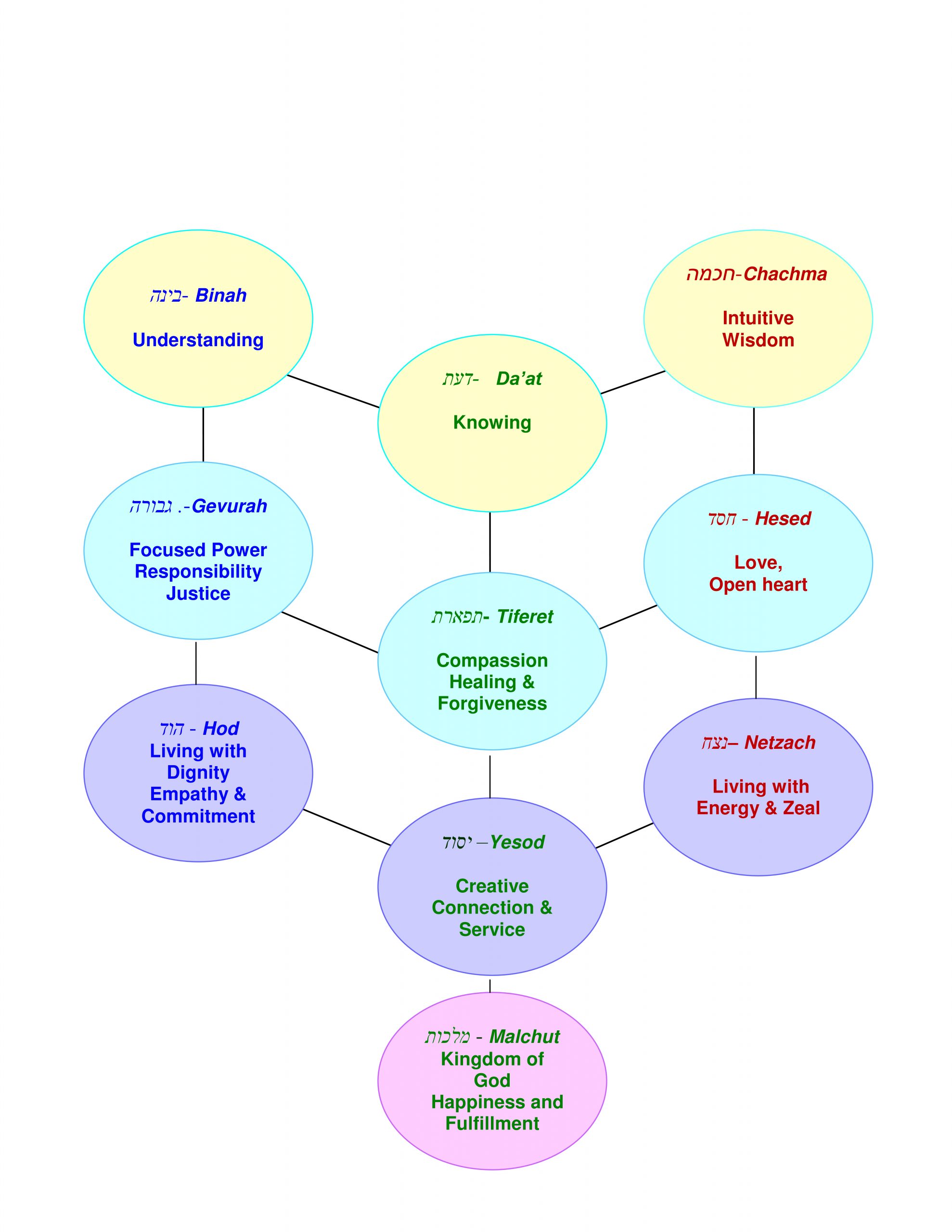SPIRITUAL INTELLIGENCE ®
Our approach is guided by the Kabbalistic Tree of Life, a road map for spiritual success and developing Spiritual Intelligence. Spiritual Intelligence refers to the ability to practice and integrate the spiritual polarities of intuitive wisdom and practical knowledge, love and responsibility, and energetic action and humility. The goals of practice include the development of mindfulness, awareness of the divine, choosing an ethical path and acting in accordance with one’s chosen values of for the benefit of self, others, community and the world.
KABBALAH AND SPIRITUAL INTELLIGENCE
The Jewish mystical tradition know as the Kabbalah is a primary source for our model of Spiritual Intelligence. The primary text of the Kabbalah is a book called the Zohar which first appeared in 13th century Spain although it draws on many earlier sources. The Zohar has developed a variety of interpretations the most important of which is found in the hasidic movement founded by Rabbi Israel Baal Shem Tov, an 18th century Jewish mystic.
In the Kabbalah there is a core teaching about the Tree of Life, a series of Sefirot/emanations through which God created the world. Each emanation is both a quality of the divine and of humans which we attempt to actualize in our lives. There are 10 sefirot (singular: sifirah) which may be grouped into 3 groups. For the purpose of developing a psycho-spiritual paradigm which may be of practical use for our time I have explored the way in which the sefirot interact and balance each, bringing a deep understanding of the psychological dynamics inherent in the model.
What follows is an interpretive description of the 10 Sefirot. The first three represent mindfulness factors. The remaining seven are middot or character traits. You will find a diagram of the 10 Sefirot below.
SEFIROT – DIVINE MANIFESTATIONS – CHARACTER TRAITS
The first three Sefirot are conceived of as mental factors.
Chochma: Intuitive wisdom
Chochma represents raw perception which yields only an intuitive, embodied impression of a situation. We may experience
Chochma as a sense of awe, as when viewing a rainbow, a sunset or a birth. It may also be experienced as raw fear.
Binah: Understanding, discernment.
As we absorb the impressions of perception we use the miraculous tools of language to compare, judge and evaluate our experience.
DA’AT: Knowledge
Da’at integrates intuitive wisdom and understanding. It is a mindful form of knowing that notices how the mind-body is responding to an experience and the way in which the mind understands that experience. The consciousness of Da’at represents an intentional fullness of knowing in the present moment that is distinct from the thoughts that often arise automatically in our daily lives. In the mystical tradition Da’at represents a mind state in which one is capable of connecting to God.
The next three Sefirot are related to a person’s inner world of feelings and managing those feelings.
Hesed: love, kindness, grace, unlimited flow
Hesed refers to the feeling of an abundant, unlimited flow of love and grace. This energy can be channeled into love or lust.
Gevurah: strength, restraint, might, justice, severity, restriction and responsibility
Gevurah represents restriction and control. Its purpose is to focus the energy of Hesed. This energy can be directed as responsibility and justice or as fear and hate.
Tiferet: beauty, compassion, forgiveness, a balance of Hesed and Gevurah
When Hesed and Gevurah are balanced the result is the affirming and healing energy of Tiferet. Combining feelings of love or concern for the suffering of others with Gevurah as responsibility yields compassion or forgiveness for wrongs committed against a person. Unbalanced, the energy of Tiferet becomes indulgence or chaos (as in addiction).
The next group of Sefirot are related to interpersonal behavior:
Netzach: victory, perpetuity, will power, energized engagement
Nezach draws from the sefirah of Hesed and reflects the love that has been received outward in deeds of loving-kindness. The energized engagement of Netzach can be directed into doing for others. Without the balancing energy of Gevurah as responsibility and Hod as humility it may generate selfishness or overbearing charisma that takes advantage of others.
Hod: glory, humility, splendor, dignity
Hod focuses the energy of Netzach just as Gevurah focuses and limits Hesed. Hod represents the humble assertion that we are all human. Its positive manifestation is seen in humility, consistency, loyalty and dignity. When Netzach overpowers Hod a person may act impulsively. With too much humility and a lack of Netzach energy a person may be taken advantage of.
Yesod: foundation, source of sexual energy, creativity, communicativity, connectivity
Yesod reflects the balance of Netzach and Hod, an energized, dignified and optimally effective ordering of one’s behavior.
The last Sefirah is one of total integration and completion:
Malkhut; sovereignty, majesty, authority, wholeness, peace, God’s Presence in the world. When all of the upper sefirot are balanced there is an abundant flow of Divine energy into the world manifest in peace, harmony and love.

LEARNING MORE ABOUT SPIRITUAL INTELLIGENCE
Now that you have learned about the basics of Spiritual Intelligence I invite you to explore our other Resources and Programs so you can continue your spiritual journey, learn some basic spiritual practices and develop the middot – character traits which will lead to a greater sense of peace, valued living and happiness.